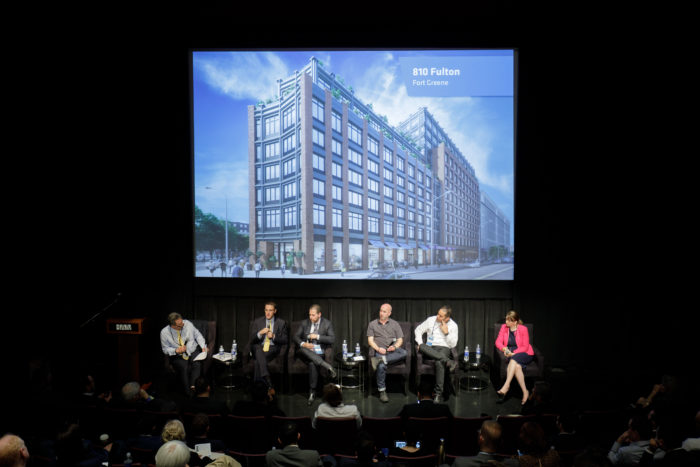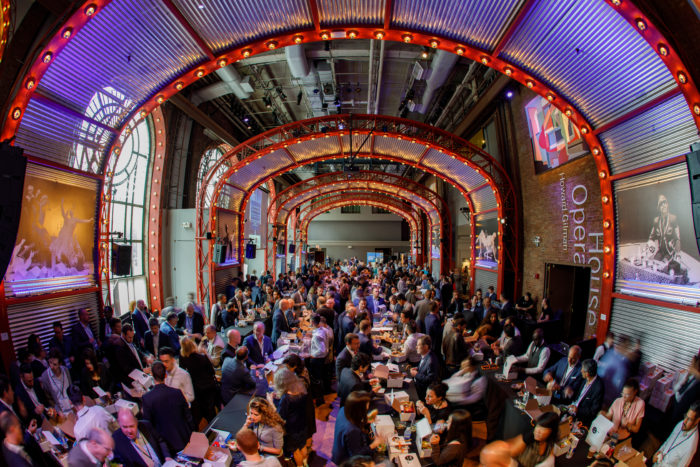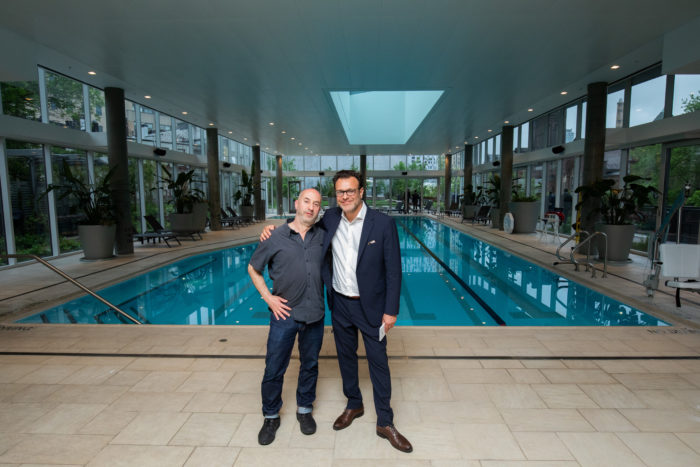In the long-running saga of Brooklyn’s real-estate boom, a bit of stability seems to have emerged. Tech and media companies keep reliably migrating from Manhattan to Brooklyn. The oversupply of new rental apartments in the Downtown area seems to be easing. And the development of amenities in both residential and office buildings seems to be meeting rising expectations. Those were among the trends noted at the Only Brooklyn conference hosted this week by the TerraCRG commercial-realty group at the Brooklyn Academy of Music, where more than 40 industry experts offered their views. Some Highlights:
Crossover Companies Multiply
A new breed of company has emerged that’s proliferating rapidly in Brooklyn and creating jobs at a variety of skill levels, according to the executives who run the Brooklyn Navy Yard and Industry City. “I now refer to our fast-growing companies as ‘crossover companies,'” said David Ehrenberg, CEO of the Navy Yard, explaining that such companies are a mix of tech, design and hardware manufacturing. He gave the example of Crye Precision, which makes body armor and other military garb. The company recently moved into a larger space at the Yard, a 90,000-sq.-ft. facility where 150 workers operate sewing machines to assemble the gear.
“We see that exploding in Industry City. It’s really exciting what’s happening,” said Andrew Kimball, CEO of the 6-million-sq.-ft. complex in Sunset Park. Businesses in its 16 buildings add about 100 jobs per month, with the total now over 6,500. Kimball cited the case of AbelCine, a company that supplies equipment and services to media companies, which moved its regional flagship facility from Manhattan to Brooklyn, where it now occupies 44,000 sq. ft. in Industry City. AbelCine’s move follows a now well-established pattern. “Most of their employees live in Brooklyn anyway,” Kimball said.

Ehrenberg, CEO of the Brooklyn Navy Yard, spoke of the surge in “crossover companies”
The result is that new facilities and vacancies fill up fast. “We just opened a 1-million-sq.-ft. building,” said Ehrenberg, referring to Building 77, a converted World War II-era office and storehouse. “It was 85% full at the ribbon-cutting and will be 100% by summer.” Asked if there is any sign of flagging demand, he said, “We’re nowhere close to it.”
With more development on the way at the Navy Yard, a non-profit owned by the city, he expects employment to reach 30,000 in coming years, up from 20,000 today. Available space in the Navy Yard is “extremely rare,” said Ehrenberg, so new tenants are chosen partly based on “jobs per square foot.”
Demand for space in Brooklyn is also growing from e-commerce companies, who need space for warehouses and distribution centers. “We’re continuing to look for new investment in Brooklyn, Queens and the Bronx,” said Zach McHugh, vice president of Sitex, which recently bought a 12-acre waterfront site in Red Hook that will be occupied by a United Parcel Service facility.
Gregory O’Connell, whose family firm developed much of Red Hook’s industrial space, offered a flashback to what the neighborhood was like a generation ago. “In the late ’80s and early ’90s, getting a small business into Red Hook was hard,” he said, requiring low leasing rates and plenty of incentives.
But Where Are the Big Companies?
Despite the growth and arrival of small- and mid-sized companies, the Brooklyn office market has yet to land a really big fish, like the headquarters of a Fortune 500 company. “There’s this barrier of crossing the bridge,” said MaryAnne Gilmartin, former CEO of Forest City New York and now co-founder and CEO of the development company L&L MAG. “Why wouldn’t you want to save hundreds of millions of dollars over the course of your lease if your workers would be happy, would be productive, and the building would be high performing?” she asked. “It only takes one very large company. Someone with vision and guts and the ability to see that it’s a good move. Once that happens, I think others will do it.”
“We need large tenants to really move Brooklyn into the big leagues,” said Regina Myer, CEO of the Downtown Brooklyn Partnership. “We are really working hard to make sure there is more interest in Brooklyn from Manhattan tenants.” Jamie Hodari, founder of the Brooklyn-based co-working company Industrious, said many companies need to be in both places. “The resistance we’ve heard is, ‘We all want to work in Brooklyn, but we’re a client-facing business. We do a lot of sales. Can we get all of our customers to come? And I think that’s one of the promises of co-working, as you start to have more operators that are all over the city. You can be based in Brooklyn and when you have to hold a sales meeting with an advertising company, you can hold it at a location on Madison Avenue.”

“Young people expect an experience in a building, not just a space,” said Brookland Capital’s Gilad.
Part of the issue is that new development in the borough, especially Downtown, has focused more on residential units instead of office space. “It is not a healthy thing for every piece of real estate to be a condominium,” said Jed Walentas, CEO of Two Trees Management, which turned Dumbo into a tech hub and is developing the old Domino Sugar refinery in Williamsburg for a mix of office and residential use. “The mostly residential-only mega projects that have been built around the city are basically terrible,” he said. “They are suburban, uninteresting places. Not from an investor standpoint, or even if you live there, but in terms of making the city a more interesting and dynamic place, it doesn’t contribute a lot.”
One recent exception to the lack of big-company outposts in Brooklyn is the arrival of a United Technologies tech center, where the Connecticut-based maker of jet engines and elevators will bring an estimated 250 new jobs. “They’re going to Dumbo, out of the whole globe,” remarked Kimball. “They said, ‘We gotta get out of Hartford,’ and they picked Dumbo.”
Posh Amenities Have Become the Norm
The comforting and entertaining amenities that used to be found only in luxury condo buildings have become standard features in new office and residential buildings, the experts said. Allison Novak, a principal with the Hudson Companies, said their new office-and-retail development in East Williamsburg is called The Breeze because when they converted the old industrial building, the developers cut a breezeway through the space so tenants could enjoy more light and air. The building will feature a lushly landscaped courtyard and a restaurant on the roof.
“Young people expect an experience in a building, not just a space,” said Boaz Gilad, co-founder of Brookland Capital, a prolific builder of residential buildings in the borough. “I care less about how much square footage I have in the bedroom, but when I go downstairs, I want to hang out with my friends.”

More than 40 experts voiced their opinions at the one-day summit at Brooklyn Academy of Music
Expectations for condos and rental units have converged, said Novak. “We used to think in a rental building you didn’t need a washer and dryer in every unit, you could just put it in the basement. Today, I wouldn’t build a rental building without one in every apartment.”
Gilad said that his company had stopped buying land for development for a couple of years because prices where too high, but is now negotiating acquisitions again. He was coy about the location, however, adding: “Wherever there’s cappuccino for $5, I’ll be there. Cappuccinio and people on bicycles.”

Developer Doug Steiner at the Hub’s swimming pool, with Ofer Cohen, CEO of TerraCRG
Are Rent Concessions Finally Easing?
For the last year, developers in Brooklyn have had to offer prospective renters concessions of one or two months’ rent, and other sweeteners, due in large part to the flood of thousands of new rental units in the downtown area. But the marketplace may be “absorbing” those new units, as they say in the industry, with sufficient speed to take pressure off the need to dangle concessions. “Recently, we have started to see rents stabilize,” said David Schwartz, co-founder of Sugar Hill Capital Partners. “It doesn’t mean we’re not having to give concessions, but even the amount of concessions that we have to give is starting to decline.”
“Concessions are no longer a secret. Buyers and brokers are all aware of concessions,” said Jordan Vogel, a principal at Benchmark Real Estate Group. “I think that we’re sort of in this stagnant area where people are trying to figure out what’s going on and that’s causing transaction volumes to go down, but at the same time, people are tired of being patient. Myself included. At this point, I’m a deal junkie.”
Doug Steiner, chairman of Brooklyn’s Steiner Studios, is also developer of the residential tower the Hub, currently the tallest building in Brooklyn. While the building’s rental site is offering “up to two months” of rent concessions, Steiner said sales have been healthy. “We’ve been leasing according to projections, if not faster,” which he attributed to the building’s amenities, including a 75-foot swimming pool. “People would be hard pressed to move out because they get used to it.” He predicted the situation will get even better next year, when downtown’s transit options will look increasingly attractive. “Downtown will be a huge beneficiary of the L [train] shutdown,” he noted.